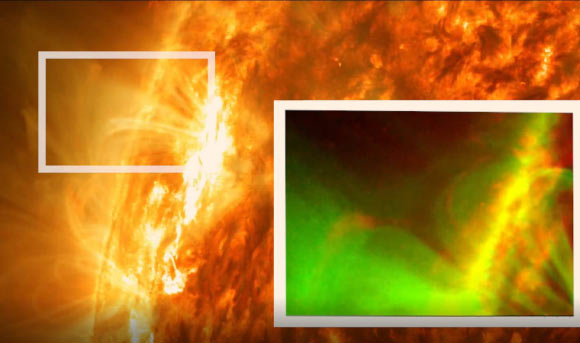Solar Dynamics Observatory Observes Forced Magnetic Reconnection in Sun’s Corona | Astronomy – Sci-News.com
NASA’s Solar Dynamics Observatory (SDO) has directly observed a new type of magnetic explosion — called forced reconnection — in the solar corona, the Sun’s uppermost atmospheric layer.

Forced magnetic reconnection, caused by a prominence from the Sun, was seen for the first time in images from SDO. This image shows the Sun on May 3, 2012, with the inset showing a close-up of the reconnection event imaged by SDO’s Atmospheric Imaging Assembly instrument, where the signature X-shape is visible. Image credit: NASA / SDO / Abhishek Srivastava / IIT.
Previously a type of magnetic reconnection known as spontaneous reconnection has been seen, both on the Sun and around Earth.
But this new explosion-driven reconnection had never been seen directly, thought it was first theorized 15 years ago.
“This was the first observation of an external driver of magnetic reconnection,” said Dr. Abhishek Srivastava, a solar scientist at the Indian Institute of Technology.
“This could be very useful for understanding other systems. For example, Earth’s and planetary magnetospheres, other magnetized plasma sources, including experiments at laboratory scales where plasma is highly diffusive and very hard to control.”
The previously-observed spontaneous reconnection requires a region with just the right conditions — such as having a thin sheet of plasma that only weakly conducts electric current — in order to occur.
The forced reconnection can happen in a wider range of places, such as in plasma that has even lower resistance to conducting an electric current. However, it can only occur if there is some type of eruption to trigger it.
The eruption squeezes the plasma and magnetic fields, causing them to reconnect.
Using multiwavelength imaging observations from the Atmospheric Imaging Assembly on board SDO, Dr. Srivastava and colleagues were able to study this plasma.
The observations allowed them to directly see the forced reconnection event for the first time in the solar corona.
In a series of images taken over an hour, a prominence in the corona could be seen falling back into the photosphere. En route, the prominence ran into a snarl of magnetic field lines, causing them to reconnect in a distinct X shape.
Spontaneous reconnection offers one explanation for how hot the solar atmosphere is — mysteriously, the corona is millions of degrees hotter than lower atmospheric layers, a conundrum that has led solar physicists for decades to search for what mechanism is driving that heat.
The study authors looked at multiple ultraviolet wavelengths to calculate the temperature of the plasma during and following the reconnection event.
The data showed that the prominence, which was fairly cool relative to the blistering corona, gained heat after the event. This suggests forced reconnection might be one way the corona is heated locally.
Spontaneous reconnection also can heat plasma, but forced reconnection seems to be a much more effective heater — raising the temperature of the plasma quicker, higher, and in a more controlled manner.
While a prominence was the driver behind this reconnection event, other solar eruptions like flares and coronal mass ejections, could also cause forced reconnection.
The scientists are continuing to look for more forced reconnection events. With more observations they can begin to understand the mechanics behind the reconnection and often it might happen.
“Our thought is that forced reconnection is everywhere. But we have to continue to observe it, to quantify it, if we want prove that,” Dr. Srivastava said.
The findings appear in the Astrophysical Journal.
_____
A.K. Srivastava et al. 2019. On the Observations of Rapid Forced Reconnection in the Solar Corona. ApJ 887, 137; doi: 10.3847/1538-4357/ab4a0c
This article is based on text provided by the National Aeronautics and Space Administration.






